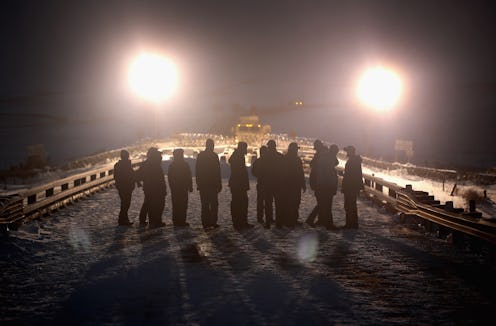News
Oil Will Soon Run Through The DAPL

With months of protest, one presidential blockage, and a subsequent presidential reversal, the Dakota Access Pipeline and the fight against it have made news for much of the last year. On March 27, the water protectors' plea took its greatest hit yet when news broke that the Dakota Access Pipeline will be in service soon, and is currently filled with oil. The fight against DAPL has rallied Native rights activists, environmentalists and more, but it appears that this specific battle is on its last legs.
Federal court filings obtained by reporters revealed that Energy Transfer Partners, the company behind the controversial pipeline, is preparing for full operation of the pipeline. In the filing, Energy Transfer Partners revealed the status of the pipeline:
Oil has been placed in the Dakota Access Pipeline underneath Lake Oahe. Dakota Access is currently commissioning the full pipeline and is preparing to place the pipeline into service.
Although the filing states that ETP is preparing the pipeline for operation, it doesn't specify when exactly it will be fully operational.
This ugly fight went from a Native and environmental activist protest a year ago to a Hollywood cause célèbre that made its way into the presidential debate. Many were joyous in Dec. 2016 when the Army Corps of Engineers blocked the pipeline, but shortly after his inauguration, President Donald Trump signed an order in favor of approving the final permits for the pipeline. A few weeks after Trump's DAPL order, the water protectors were evicted from the Oceti Sakowin camp on the Standing Rock Sioux reservation, and they ceremonially burned their camp in protest.
Despite the executive back-and-forth about the pipeline and their many setbacks, Native activists are keeping the fight alive. Despite being denied an injunction to halt the pipeline on religious grounds in early March, the Cheyenne River Sioux Tribe are continuing to raise money for their legal challenge to the pipeline. As the "silent sister" of the Standing Rock Sioux Tribe, the Cheyenne River Sioux and their chairman Harold Frazier have advocated for their fellow Sioux through the duration of the fight against the DAPL.
On their crowdfunding page, the Cheyenne River Sioux Tribe denoted two distinct legal strategies they're deploying to fight the pipeline: one based on religious freedom laws (which were denied in their most recent request) and one based on treaty and environmental challenges.
With a decidedly oil-friendly administration in Washington, there's no hope of another presidential injunction to stop the oil from flowing under Lake Oahe. But the Native people leading the fight against the pipeline don't seem to be backing down anytime soon.